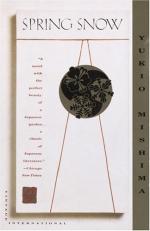|
This section contains 569 words (approx. 2 pages at 400 words per page) |

|
Spring Snow Summary & Study Guide Description
Spring Snow Summary & Study Guide includes comprehensive information and analysis to help you understand the book. This study guide contains the following sections:
This detailed literature summary also contains Topics for Discussion and a Free Quiz on Spring Snow by Yukio Mishima.
"Spring Snow" is the first in a series of four novels collectively called "The Sea of Fertility." The other novels in the cycle are "Runaway Horses," "The Temple of Dawn," and "The Decay of the Angel." This novel demonstrates the impacts of the "modernization" of Japan from a feudalistic, patriarchal, and aristocratic society into something more fluid and democratic. These changes are revealed in the story of a pair of lovers, one from an old aristocratic family and the other from upwardly-mobile middle class origins. The complication is that Satoko, the young woman, does not want to marry Prince Harunori Toin to please their families but is afraid of her growing passion for Kiyaoki. Her subsequent flight from reality into a convent, probably symbolizing the way that Buddhism provides stability for Japanese in a time of social upheaval, causes great distress for everyone and is a plot device to lend their plight a tragic hue.
Since this is a work in translation, it is difficult to know whether the English translation fails to do justice to the original work, or whether the author has failed to present his characters as anything more than two dimensional. This is a truly tragic love story of the same order as "Romeo and Juliet" that somehow fails to arouse deep emotion or even much empathy on the part of the reader. There may be both a linguistic as well as cultural barrier between the novel and English-speaking readers, but because of this failure the story seems driven by the author's need to present old and new patterns in Japanese society in conflict so that the characters become secondary to the plot design. The novel's forward momentum derives from conflicting structural patterns as much, or more, than from genuine human feeling.
Of course, that may well be the author's intention: to show how a paternalistic, hierarchical, rigid society distorts and drains away real emotion and demands of its citizens a kind of kabuki dance in relationships of the heart. When the lovers, Kiyoaki and Satoko, indulge their passion for each other, tragedy ensues, perhaps because they are so ill-equipped to deal with their powerful emotions because of their rigidly-controlled upbringing. Kiyoaki, as a youth of 18 in his first serious love affair, plays out a futile effort to somehow make Satoko his own, while she enters a convent, breaking off her arranged engagement to a member of an aristocratic family and making herself completely inaccessible to her lover ,who falls ill from self-neglect in her pursuit and dies at the age of 20.
Possibly the author intended to show that true passionate love between people in Japan of 1912 was doomed. However, after all the twists and turns of the narrative, Kiyoaki's death at the end of the novel seems absurd rather than tragic because of the author's failure to bring these two lovers to life in three dimensions throughout the narrative. As a sociological work, "Spring Snow" is quite informative and engaging because of its presumed historical accuracy. However as a story of flesh-and-blood young lovers, it fails to deliver the full impact of real tragedy perhaps because there seems to be nothing at stake in their relationship except a juvenile type of willfulness. A more nuanced approach that showed the emotional contradictions of the characters—their fears, pride, and frustrations—would probably elicit the missing element of reader empathy.
Read more from the Study Guide
|
This section contains 569 words (approx. 2 pages at 400 words per page) |

|



